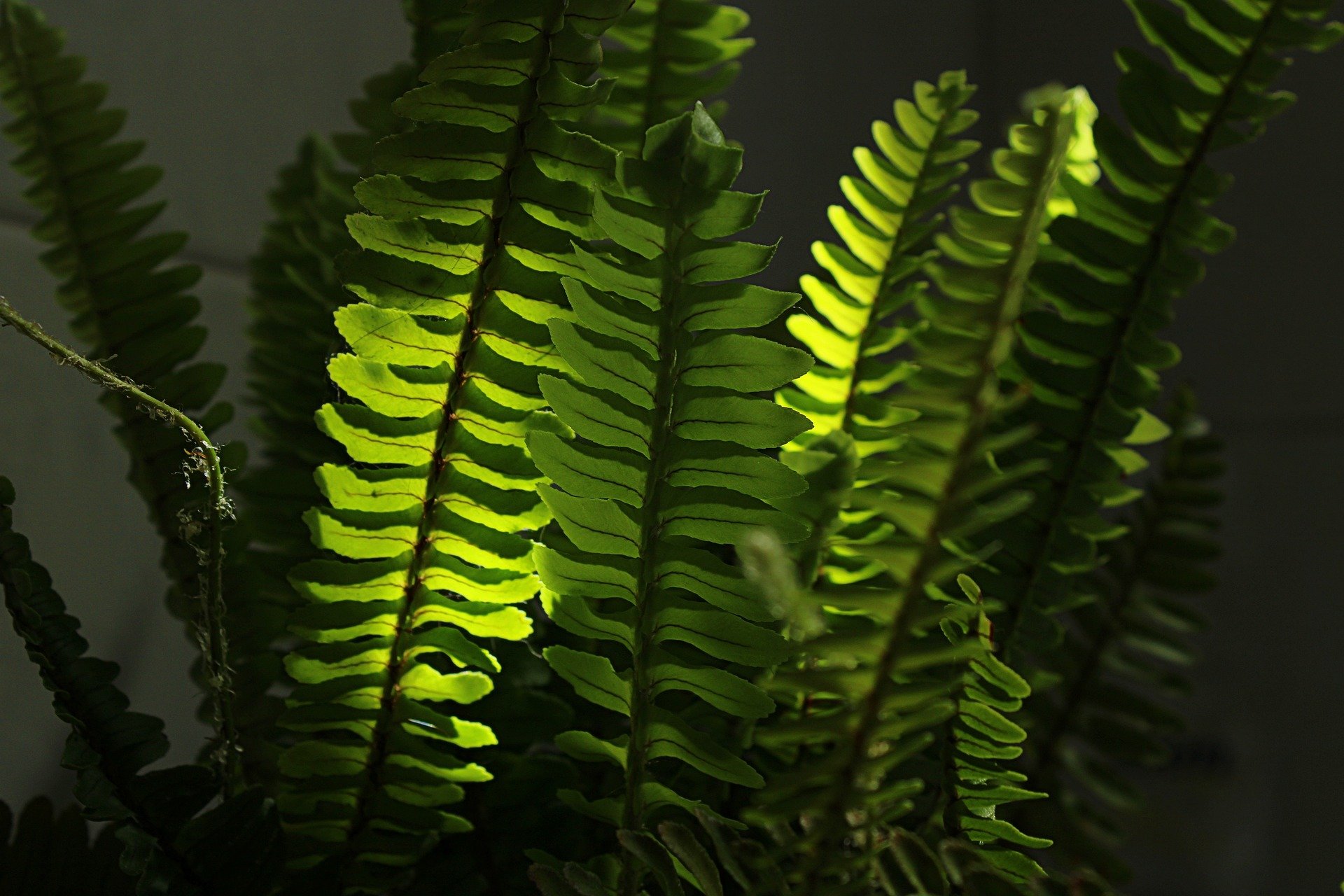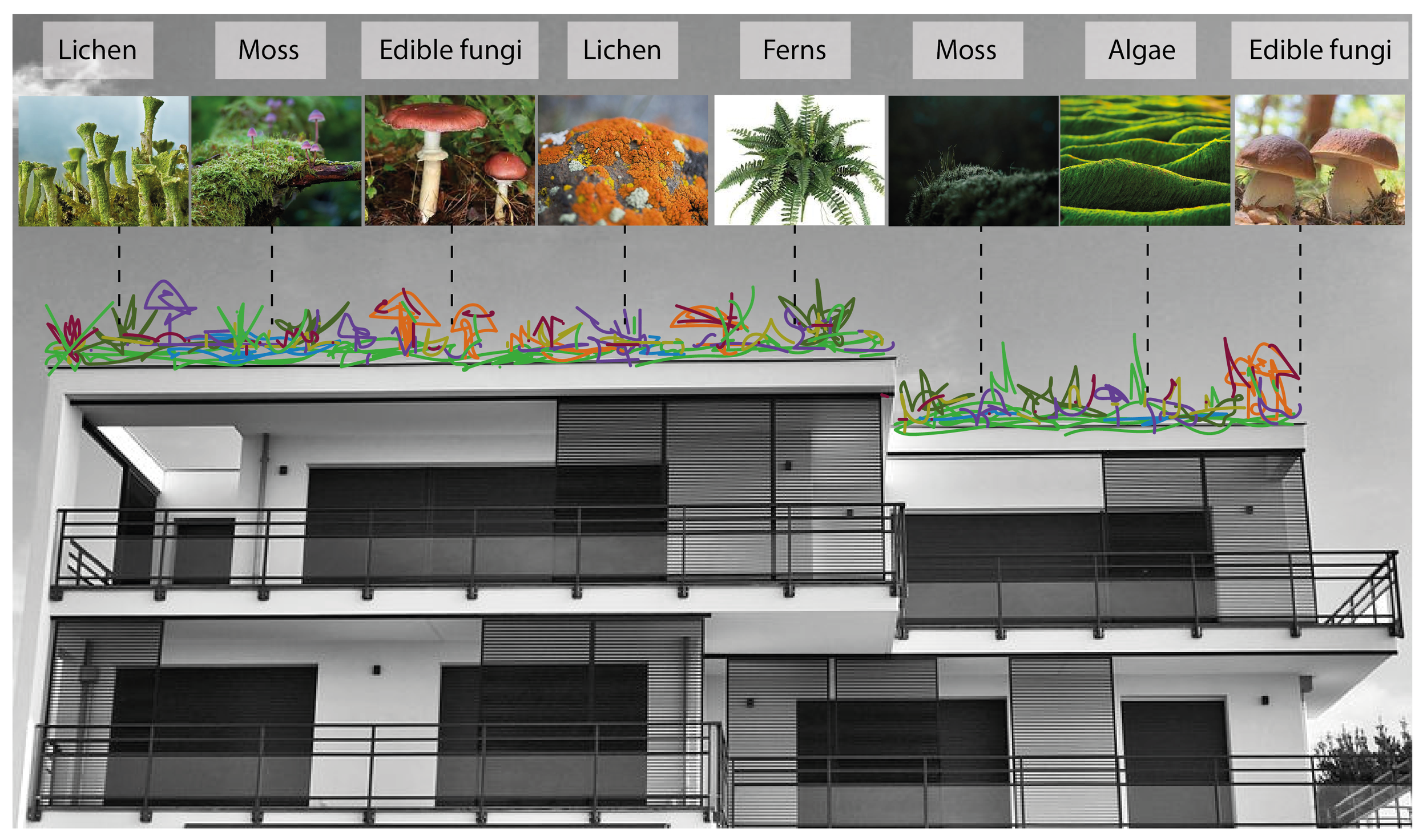Cryptogams and living roofs
By Jake Robinson
I’m sitting on a log, watching the crispy leaves dancing in the breeze; winter’s chilly promise is just around the corner. Golden-brown acorns snuggle into the leaf litter. Surrounded by puffball mushrooms – some a little gnarly, waiting to disperse their seven trillion spores, others fresh and ready to sauté. The boulders are hugged by a fluffy cloak of moss, their edges decorated by algae, like glistening jade necklaces. The tree bark and rocks are covered in sunburst lichens, and a stand of curly ferns embellishes the margins in the distance. It’s a mini theatre of cryptogams!
Crypto who?
Cryptogams, like microbes, are under-valued organisms. Although it sounds like blockchain technology, the term ‘cryptogam’ is given to plants and plant-like organisms that multiply themselves by producing near-invisible spores. They don’t produce flowers or seeds, which you can typically see with the naked eye. And that’s where the name comes from – crypto means hidden, and gam or gamete means reproductive cell, so ‘hidden reproductive cells’. Cryptogams include lichens, mosses, algae, ferns, and fungi.
Ten years ago, the Max Planck Institute of Chemistry in Germany calculated that the cryptogams covering the planet’s soils, rocks, and trees — and more recently, building surfaces — sequester around 4 billion tonnes of CO2 per year, corresponding to more CO2 than is emitted by all of the world’s cars combined. This is incredible, yet we rarely hear about cryptogams. The Max Planck scientists also suggested that cryptogams take up around 49 million tonnes of atmospheric nitrogen (N2) annually. This means cryptogams account for approximately 50% of the biological nitrogen fixation on land.
Lichens
I’ve written before about how lichens are a form of nested symbiosis. They’re a fascinating conglomerate of fungi (mycobionts) and algae and/or cyanobacteria (photobionts) working together with a core, symbiotic microbiome. They cling to surfaces such as tree bark and rocks and play important roles in ecosystems. Yet to many urban dwellers, they’re an unjustified nuisance; sadly, a lichen’s destiny is often to be jet-blasted into oblivion. Around 20,000 known lichen ‘species’ exist, and they often have some incredibly beautiful features; they’re like tiny open jewellery boxes of complexity.
Beautiful lichen amongst the moss
Mosses
Mosses are equally valuable (intrinsically and instrumentally) but equally demonised as nuisance organisms. If you type “how to remove moss”, “how to get rid of moss”, and “how to kill moss” into a well-known search engine you’ll receive 654,000, 122,000, and 24,000 hits, respectively. Our obsession with scraping these miniature ecosystems away is astounding. Mosses are ancient plants, and over 300 million years ago, vast areas of the Earth’s surface were covered in luscious moss carpets, pumping out oxygen. Along with cyanobacteria, we have the humble moss to thank for much of the oxygen we breathe today. Some are known to survive temperatures of 100ºC and -272ºC. They stabilise soil, retain water to help other organisms thrive, and provide valuable shelter for visible and invisible biodiversity. A single gram of moss can support 130,000 tardigrades and 3,000 springtails!
Emerald moss-covered rocks
Algae
Like mosses, algae are autotrophs – they generate their energy via photosynthesis. They’re typically found in aqueous environments like lakes, rivers, and oceans. But algae also live in the upper layer of soil. Most soil algae act as cementing agents that bind particles together (called ‘aggregates’), thereby preventing soil erosion. They can liberate large quantities of oxygen through photosynthesis in the soil, thus facilitating soil aeration. Algae also maintain soil fertility by transforming sunlight and CO2 into sugars, which insects, tardigrades, and crustaceans feed upon.
Algae-draped rocks
Ferns
Ferns and closely related groups are also cryptogams. Fern plants are capable of producing millions of spores. Each dispersed spore, often aided by the wind, can potentially give rise to another plant. They appeared millions of years before dinosaurs and still thrive in various environments today. Ferns can grow to a colossal size like towering green cathedrals, but tiny ferns also exist; for instance, Azolla Cristata is a water fern with 5 mm fronds. Ferns provide vital microhabitats for small animals.
Ferns are also cryptogams
Fungi
Unlike the other cryptogams, which are autotrophs, fungi are heterotrophs, meaning they acquire their energy by feeding on organic matter. Three main groups of fungi exist (although these can be subdivided into many others):
1. Multicellular filamentous moulds
2. Macroscopic filamentous fungi that form large fruiting bodies, i.e., mushrooms!
3. Single-celled microscopic yeasts
Fungi make up some of the largest and smallest organisms on the planet. Scientists estimate that 3.8 million species exist. They’re the unsung heroes of trees and other plants. Indeed, mycorrhizal fungi form essential symbiotic relationships with soil bacteria and plant roots, allowing plants to draw in water and nutrients and communicate with each other. In return, the plant roots shuttle carbon, sugars, and other beneficial ‘exudates’ to the fungi. The structures and colours of fungi can be stunning.
Fungi are also cryptogams - but they don’t photosynthesise! Pictured: cep - also known as porcini or penny bun.
Cryptogam roofs
Sitting on my log in this wild cryptogam theatre, I wonder why we never see cryptogam ‘living roofs’ in urban areas. The green roof industry has boomed in the last decade. Central London alone has at least 700 green roofs, covering an area of over 175,000m2. Yet most of these are composed of sedum, a low-growing perennial succulent plant.
I’m aware that moss mats exist for roofs, and architects and biologists at the Bio-ID lab (UCL) are creating ‘bioreceptive’ materials to encourage lichens, algae and moss to colonise the architectural skins of our urban jungles. Moreover, Prof. Jorg Sieweke at NMBU in Norway has proposed lichen-dominated roofs. But I’ve yet to see a designed roof dedicated to a rich conglomerate of mosses, fungi, algae, lichens and ferns. This could not only be aesthetically beautiful but ecologically valuable – recall from earlier in the blog that cryptogams can sequester huge amounts of carbon, fix nitrogen, and support a diverse collection of animal life.
Dedicated cryptogam roofs could be compositionally and structurally diverse, supporting an array of shapes, colours and, most importantly, biodiversity! I envisage low-level mosses and lichens, complemented by towering edible mushrooms and non-toxic ferns with pleasing fractal patterns. Cryptogam roofs could contribute to urban biodiversity and climate change mitigation.
Moss and lichens already colonise roofs, but we blast them away.
If it’s not already being done (and I’d love to hear more if it is!), I propose further research to develop optimal cryptogam roof designs. These designs should consider various environmental conditions and innovative features to encourage cryptogram growth and sustenance. Each cryptogam group will require slightly different considerations which can be curated at a micro-scale: aspect, shading, substrate (and mulch top-ups), nutrients, moisture, and understanding phenology will be important. Moreover, determining the roles of microbes in cryptogam bio-colonisation and maintenance will likely be key. I’m currently working with researchers at UCL (London) and NMBU (Norway) to understand how microbial inoculants can lend a helping hand, so watch this space!
Could some green roofs of the future be dominated by cryptogams - including edible mushrooms?
In the future, we may look at urban roofs and marvel at the beauty of the lichens, say “no” to jet-blasting the moss, harvest tasty rooftop mushrooms, and herald the algae and ferns as the new ‘green’.








